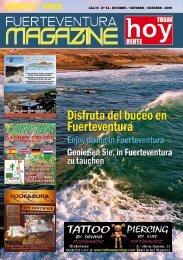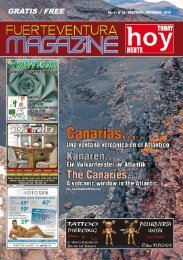GRATIS / FREE TIS / FREE - fuerteventura magazine hoy
GRATIS / FREE TIS / FREE - fuerteventura magazine hoy
GRATIS / FREE TIS / FREE - fuerteventura magazine hoy
Create successful ePaper yourself
Turn your PDF publications into a flip-book with our unique Google optimized e-Paper software.
FUERTEVENTURA MAGAZINE <strong>hoy</strong><br />
<strong>hoy</strong><br />
AZAHAR<br />
Citrus aurantii flos = Flor de naranjo amargo<br />
Citrus sinensis flos = Flor de naranjo dulce<br />
FAMILIA: RUTACEAE<br />
ALGO DE LA HISTORIA<br />
Cuenta Viera y Clavijo en su obra «Historia Natural<br />
de las Islas Canarias»: «Preciosa flor que matiza, alegra<br />
y perfuma, con más o menos abundancia, nuestros<br />
campos y verjeles canarios, durante todo el año,<br />
a beneficio de la dulce benignidad del clima… Del azahar<br />
se hacen conservas, confituras, aguas de olor,<br />
pomadas, mantecas, cordiales. Tiene virtud cefálica,<br />
estomacal, antihistérica, vermífuga».<br />
DESCRIPCIÓN<br />
Continúa Viera y Clavijo: «Compónense de<br />
ramilletitos de flores que nacen en el remate de los<br />
gajos; y consta cada flor de un cáliz pequeño con cinco<br />
puntas, cinco pétalos oblongos, blancos, a veces<br />
matizados de púrpura; veinte estambres chatos, unidos<br />
en manojillos por sus bases, con anteras o borlillas<br />
de color de oro; y un germen casi esférico del cual se<br />
forma el fruto».<br />
ORIGEN Y ECOLOGÍA<br />
Ambas plantas son originarias de Asia. Cultivadas.<br />
No amenazadas.<br />
LOCALIZACIÓN<br />
En cultivos con finalidad comercial y en huertas familiares.<br />
PARTE UTILIZADA<br />
Flor o botones florales desecados, mejor recolectarlos<br />
aún cerrados que ya totalmente abiertos.<br />
PRINCIPIOS ACTIVOS FUNDAMENTALES<br />
- Aceite esencial: monoterpenos (acetato de linalilo,<br />
linalol, alfa pineno, limonemo, nerol, geraniol,<br />
antranilato de metilo.<br />
- Sustancias amargas<br />
- Flavonoides<br />
PROPIEDADES E INDICACIONES TERAPÉUTICAS<br />
Deriv Derivadas Deriv adas de de de la la e eexperiencia<br />
e xperiencia de de uso uso tradicional<br />
tradicional<br />
«Se emplea generalmente para combatir dolores de<br />
ORANGE BLOSSOM<br />
Citrus aurantii flos = bitter orange flower<br />
Citrus sinensis flos = sweet orange flower<br />
FAMILY: RUTACEAE<br />
A BIT OF HISTORY<br />
Viera and Clavijo in their book «Natural History of<br />
the Canary Islands» : speak about this «Beautiful flower<br />
that clears, brightens up and perfumes, with more or<br />
less strength, our fields and Canarian orchards, all year<br />
round, thanks to the year long mild climate…With<br />
orange blossom one can make preserves, jam, scented<br />
water, ointment and cordials. It has properties to<br />
soothe headache, stomach cramps, anxiety attacks<br />
and can be used as a vermifuge».<br />
DESCRIPTION<br />
Viera and Clavijo add that «It is made of little<br />
branches of flowers that grow at the end of the<br />
segment; each flower consists of a small chalice with<br />
five points, five white, sometimes light purple, oblong<br />
petals; twenty flat stamens, joined up at their base<br />
with gold coloured anthers; and an almost spherical<br />
germ that will develop into the fruit».<br />
ORIGINS AND ECOLOGY<br />
Both plants come from Asia. It is cultivated and not<br />
in danger of extinction.<br />
LOCATION<br />
It is cultivated for commercial purposes and in private<br />
orchards.<br />
PARTS USED<br />
Flower or dried flower bud, better collected when still<br />
closed rather than already fully opened.<br />
cabeza, nervios estomacales y ataques de histeria. Es<br />
una flor sedante, calma las tensiones y espasmos<br />
nerviosos, y regula la tensión sanguínea». (José Jaén.<br />
1984).<br />
Según Según el el cont contenido cont enido en en principios principios activ activ activos activ os o o ensaensayos<br />
os farmacológicos<br />
farmacológicos<br />
Las sustancias aromáticas contenidas en el aceite<br />
esencial pueden justificar su acción antiespasmódica,<br />
sedante e inductora del sueño.<br />
Deriv Derivadas Deriv adas de de ensa ensayos ensa os clínicos clínicos<br />
clínicos<br />
Avaladas aladas por por ESCOP ESCOP o o o Comisión Comisión E E u u u OMS<br />
OMS<br />
EFECTOS ADVERSOS, INCOMPATIBILIDADES Y<br />
PRECAUCIONES<br />
No existen datos empíricos ni estudios específicos,<br />
farmacológicos o clínicos, sobre la toxicidad de esta<br />
planta. Seguir las «precauciones fundamentales en la<br />
utilización popular de las plantas medicinales.<br />
FUNDAMENTAL ACTIVE PROPERTIES<br />
- Essential oils: monoterpene (linalyl acetate, linalool,<br />
alfa-Pinene, limonemo, nerol, geraniol, methyl<br />
antranilate.<br />
- Sour substances<br />
- Flavonoides<br />
39<br />
39<br />
DOSIS Y FORMA DE ADMINISTRACIÓN<br />
Infusión de una cucharada de las de postre de 5 ml.<br />
= 2-3 grs. flores secas de azahar, para una taza de<br />
agua de 150 ml.; verter el agua hirviendo sobre la planta,<br />
dejar reposar tapada durante 5 a 10 mins., para<br />
después colar y tomar. Tres veces al día.<br />
EJEMPLOS DE UTILIZACIÓN<br />
Infusión estomacal:<br />
- Azahar o flores de naranjo amargo o dulce<br />
- Manzanilla, flores.<br />
- Hierba huerto, hojas.<br />
Preparar una infusión con una mezcla a partes iguales<br />
de las tres plantas. Tomar una cantidad alrededor<br />
de una cucharada de las de sopa de 10 ml. = 3-5 grs.;<br />
para una taza de agua de 150 mls., verter agua hirviendo<br />
sobre las plantas, dejar reposar tapada durante<br />
5 minutos par después filtrar y tomar. Tres veces al día.<br />
PROPERTIES AND THERAPEUTIC INDICATIONS<br />
From om traditional traditional use<br />
use<br />
«It is generally used to combat headaches, stomach<br />
cramps and anxiety attacks. It is a sedative, calms<br />
tensions and nervous spasms, and regulates blood<br />
pressure». (José Jaén. 1984).<br />
From om its its activ active activ e principles principles and and pharmaceutical<br />
pharmaceutical<br />
trials<br />
trials<br />
Its antispasmodic, sedative and sleeping agent<br />
properties are due to the aromatic substances<br />
contained in its essential oil.<br />
From om clinical clinical t ttes<br />
t es ests es ts<br />
Bac Backed Bac ed up up bb<br />
by b y ESCOP<br />
ESCOP<br />
ADVERSE EFFECTS, INCOMPATIBILITIES AND<br />
PRECAUTIONS<br />
There is no ancient data, nor specific,<br />
pharmaceutical or clinical studies about the toxicity of<br />
this plant. It is recommended to follow fundamental<br />
precautions regarding the use of popular medicinal<br />
plants.<br />
DOSAGE AND ADMINISTRATION<br />
Infusion of one 5 ml. desert spoon = 2-3 gr. of dried<br />
orange blossom, for one 150ml. cup of water; pour<br />
boiling water on the plant, cover for 5 to 10 mns, then<br />
drain and drink, take three times a day.<br />
EXAMPLES OF USE<br />
Stomach soothing infusion:<br />
- Orange blossom or sour or sweet orange flowers<br />
- Camomile flowers<br />
- Mint leaves<br />
Prepare an infusion with an equal mix of all three<br />
plants. Take a 10 ml. table spoon of the mix = 3-5 gr.<br />
for a 150 ml. cup of water, pour boiling water over the<br />
plants and cover for 5 minutes, then drain and drink,<br />
take three times a day.














